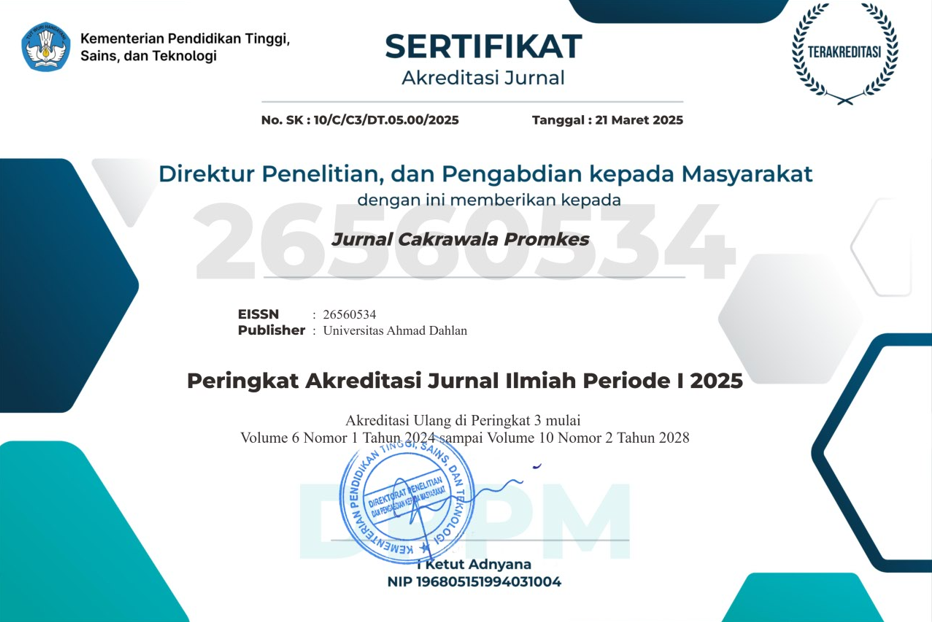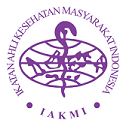Tingkat pengetahuan ibu tentang pemantauan gerakan janin pada ibu hamil dengan preeklampsia
DOI:
https://doi.org/10.12928/promkes.v3i1.2848Keywords:
Knowledge level, Fetal movement, Pregnant, PreeclampsiaAbstract
Preeclampsia is a pregnancy complication that can cause fetal and maternal morbidity and mortality. One way that pregnant women can reduce the risk of pregnancy complications is by monitoring the fetus's movement. The mother must know about monitoring fetal movements by analyzing fetal movements. The mother can detect the health of the fetus from an early stage. This study aims to determine the level of knowledge about monitoring fetal movement in pregnant women with preeclampsia. This quantitative research uses a simple descriptive design. The study's location is in the inpatient room of Teratai 1 and the Arifin Ahmad Hospital's obstetrics department, Riau Province. The population is 85 people. The selected sample amounted to 46 people with accidental techniques. The data was collected using a questionnaire and then analyzed univariately. The study found that 80.4% of pregnant women lacked knowledge about monitoring fetal movements. Pregnant with preeclampsia need to pay more attention to their fetal movements by seeking more information from health services and other sources, such as social media. Lack of monitoring of fetal movements and maternal knowledge about it causes fetal and maternal mortality rates to be challenging to reduce. Therefore, health workers must be more active in educating about pregnant women's health problems with preeclampsia to achieve the SDGs target in reducing infant and maternal mortality.
References
2. Kemenppa RI. Profil Kesehatan Anak Indonesia Tahun 2018. 2018. 58 p.
3. Kementerian Pemberdayaan Perempuan dan Perlindungan Anak dan Badan Pusat Statistik. Profil Anak Indonesia Tahun 2019. Kementeri Pemerdayaan Peremp dan Perlindngan Anak. 2019;378.
4. Gongora MC, Wenger NK. Cardiovascular complications of pregnancy. Int J Mol Sci. 2015;16(10):23905–28.
5. Tessier DR, Yockellâ€Lelièvre J, Gruslin A. Uterine spiral artery remodeling: the role of uterine natural killer cells and extravillous trophoblasts in normal and highâ€risk human pregnancies. Am J Reprod Immunol. 2015;74(1):1–11.
6. Detiana P. Hamil Aman dan Nyaman di Atas 30 Tahun. Media Pressindo; 2010.
7. Lowdermik DL, Perry SE, Cashion K. Keperawatan Maternitas Edisi 8 Buku 1. Singapore: Elsevier Pte Ltd; 2013.
8. Delaram M, Jafarzadeh L. The effects of fetal movement counting on pregnancy outcomes. J Clin diagnostic Res JCDR. 2016;10(2):SC22.
9. Enkhmaa D, Wall D, Mehta PK, Stuart JJ, Rich-Edwards JW, Merz CNB, et al. Preeclampsia and vascular function: a window to future cardiovascular disease risk. J Women’s Heal. 2016;25(3):284–91.
10. Flenady V, Ellwood D, Bradford B, Coory M, Middleton P, Gardener G, et al. Beyond the headlines: Fetal movement awareness is an important stillbirth prevention strategy. Women and Birth. 2019;32(1):1–2.
11. Nursalam D. Manajemen Keperawatan" Aplikasi dalam Praktik Keperawatan Profesional. Salemba Medika; 2014.
12. Riyanto A. Aplikasi metodologi: penelitian kesehatan. Nuha Medika; 2011.
13. Nursal DGA, Tamela P, Fitrayeni F. Faktor Risiko Kejadian Preeklampsia pada Ibu Hamil di Rsup Dr. M. Djamil Padang Tahun 2014. J Kesehat Masy Andalas. 2017;10(1):38–44.
14. Sutrimah S, Mifbakhudin M, Wahyuni D. Faktor-faktor yang Berhubungan dengan Kejadian Preeklampsia pada Ibu Hamil di Rumah Sakit Roemani Muhammadiyah Semarang. J Kebidanan. 2015;4(1):1–10.
15. Wawan A, Dewi M. Teori dan Pengkukuran Pengetahuan, Sikap Dan Perilaku Manusia: Yogyakarta. Nuha Medika. 2011.
16. Notoatmodjo S. Metodologi penelitian kesehatan. PT. Rineka Cipta; 2012.
17. Budiarti V, Putri R, Amelia CR. Hubungan karakteristik ibu dan dukungan suami dengan tingkat pengetahuan ibu hamil tentang tanda bahaya kehamilan. J Issues Midwifery. 2018;2(1):1–18.
18. Prabavathy M, Dash MB. Assess the knowledge of fetal movements count among antenatal mothers in RGGWCH, Puducherry. Innov J Nurs Healthc. 2017;2(4):2–4.
19. Bradford BF, Cronin RS, McKinlay CJD, Thompson JMD, Mitchell EA, Stone PR, et al. A diurnal fetal movement pattern: Findings from a cross-sectional study of maternally perceived fetal movements in the third trimester of pregnancy. PLoS One. 2019;14(6):e0217583.
20. Hatini EE. Pendampingan Pengkajian Kesejahteraan Janin Pada Ibu Hamil Trimester Iii di Kelurahan Kereng Bangkirai. Pros Pengabmas. 2018;1(1):152–7.
Downloads
Published
Issue
Section
License
Authors who publish with JCP: Jurnal Cakrawala Promkes agree to the following terms:
- Authors retain copyright and grant the journal the right of first publication with the work simultaneously licensed under a Creative Commons Attribution License (CC BY-SA 4.0) that allows others to share the work with an acknowledgement of the work's authorship and initial publication in this journal.
- Authors are able to enter into separate, additional contractual arrangements for the non-exclusive distribution of the journal's published version of the work (e.g., post it to an institutional repository or publish it in a book), with an acknowledgement of its initial publication in this journal.
- Authors are permitted and encouraged to post their work online (e.g., in institutional repositories or on their website) prior to and during the submission process, as it can lead to productive exchanges, as well as earlier and greater citation of published work.

This work is licensed under a Creative Commons Attribution-ShareAlike 4.0 International License












